|
FAQs about Conch Snails, Family Strombidae
& including Fasciolariidae (which includes the Horse Conches,
Spindle Shells, Tulip Snails...),
Lambis...
Related Articles: Gastropods, Sea Slugs, Mollusks, Abalone,
Related FAQs: Marine Snails 1, Marine Snails 2, Marine Snails 3, Marine Snails 4, Snail ID 1, Snail ID 2, Snail Behavior, Snail Selection, Snail Compatibility, Snail Systems, Snail Feeding, Snail Disease, Snail Reproduction, Mollusks, Sea Slugs, Abalone,
|
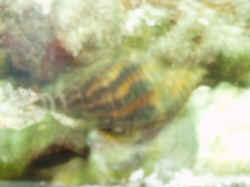
|
Clams and conchs compatible. 2/23/16
Hi all,
<Gail>
I have a 125 gallon reef aquarium and have had 1 Tonga Conch, 1 Asian Conch for
about 1&1/2 yrs. Recently, I tried 2 Tridacna deresa clams (not at same time).
They would do very well for 1-2 months then I would find their shell empty and
no clam in sight.
<Mmm>
I have a few left handed hermit crabs, 2 clownfish, 1 Carpenter's Flasher
Wrasse, 2 Pajama cardinals, 1 Randall's goby, 1 pistol shrimp, 2 skunk cleaner
shrimps, 1 pink spotted goby and 1 rose Bubbletip anemone.
<Mmm; again... Conchs by and large leave Tridacnids be; some species will bug
them by crawling over. The shrimps might be at fault here; but... more likely
there are some other hitchhikers... I'd be baiting some traps... See WWM re
Polychaetes:
http://www.wetwebmedia.com/polychaecompfaqs.htm
I have noticed the Tonga conch around the clams briefly searching them but then
they move on. I would like to try another clam but am wary.
Also, I am considering purchasing a Fromia (tile) starfish. I have read that
they are reef safe but are they really invertebrate safe?
<Yes re the genus Fromia stars. Please see our coverage re on WWM. Bob Fenner>
Gail K Ray
Re: Clams and conchs compatible.
Thanks for your timely response. Yes, I have seen bristleworms in the live
rock-catch them when I can.
Gail
<Ah; do read re the trapping, removal... B>
Re: Clams and conchs compatible. 2/23/16
I have had pretty good luck not feeding until the end of the day, then with
lights off, sprinkling some frozen fish food in the water. It usually
brings them out. I use a red light to see to catch them. Haven't had any luck
with traps-tried just about everything.
<Mmm; just narrow mouthed glass jar... with various meaty baits...?>
I'll do another "worm hunt" before I try another clam and decrease the amount of
food I'm putting in the tank. It's great to have WWM to ask these questions.
Thank you again.
Gail K Ray
<Certainly welcome. B>
|
Surprise...conch! Not striped, but spotted. Dealer a cheetah?
1/13/16
Hi Crew!
<Dani>
My husband felt this conch would be a good gift. We had a little talk about
that! The local fish store told him it was a reef-safe, Tiger conch.
<?!>
I haven't found one picture on the internet or on WetWebMedia that confirms that
though... Different color variation perhaps? I appreciate any help on the ID, thank
you!
<.... can't quite make out from your pix; but from the markings this looks like a Buccinid, a
whelk.... But not the opening. Bob Fenner>
Dani
|
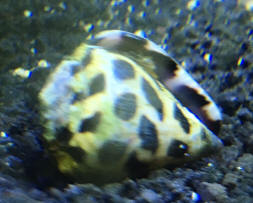
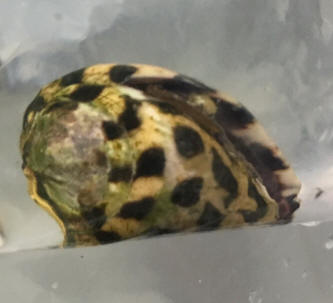 |
Queen Conch and Hermit Feeding -- 12/19/11
I'm George
<Hello George, I'm Lynn, how may I help you today?>
'¦and I have a Queen Conch.
<Oh boy, I hope you have a big tank! These snails can get up to
about a foot in length and have voracious appetites.>
My concern is that she's not getting a good diet as my tank is too
clean.
<Ouch, that's going to be a problem. Queen Conchs do better in
nutrient-rich systems of considerable size with large areas of open
sand bed, a good supply of organic debris/detritus, as well as algae
and/or sea grasses. Unfortunately, most of these beautiful snails
starve to death in reef tanks.>
What can I buy her that she will get great nutrition from eating?
She's about 3-4 inches.
<I can't say it would be great, or complete nutrition-wise, but
you might try offering some dried Nori/seaweed (used for sushi). You
should be able to find it in packets at most grocery stores in the
Asian section or at your local (pet) fish store. Of note is that
it's formed into thin sheets that fall apart pretty easily once wet
so your best bet is to rubber band it to a rock and place it near the
Conch on the substrate.>
Thanks.
Also the scarlet hermits, what to feed?
<I'd offer meaty bits of marine origin (shrimp, fish, squid,
etc.), and/or possibly sinking pellets. They may pick a bit at the Nori
as well.>
Thanks!
<You're very welcome, George! Take care, Lynn Z>
Re: Queen Conch and Hermit Feeding - 12/20/11
Thank You
<You're very welcome, George. Take care, Lynn Z>
|
Possible ID please? snail and crab
11/13/10
Greetings to you and the crew,
<Richard>
Once again I find myself relying on your expertise to sort out
the miss-information I've gained through my research
attempts.
The snail I have come to believe could be a whelk of some sort...
but have also researched that since this shell does not display a
body two times longer then the spire, so it isn't.
<Mmm, give a read here: http://reefkeeping.com/issues/2005-11/rs/index.php
Unfortunately, I can not confirm where the little guy is from.
All the live rock is about a year or more old and was touted as a
combo of Fiji and Florida, with any frag/coral spending 8 to 10
weeks in isolation minimum... so I actually have no idea how long
it has been in there. I have him in a container with a small
piece of krill mash hopeful to observe it eat as I have read that
whelks can/do not eat algae - but apparently being captured has
put off his appetite. Could you possibly confirm what he is
please?
<Likely a Conch...
http://wetwebmedia.com/MolluscPIX/Gastropods/Prosobranch%20PIX/Conchs%20Strombids/ConchF1.htm>
On a side note - could it be the reason for the die-off on the
Monti?
<Mmm, not at all likely>
The crab was found on a piece of Haitian rock (still in
isolation) and I am thinking Mithrax...
<The genus? Nah>
'cept I can't find any as fuzzy or grainy as he is. Of
course, there isn't a wealth of 'identified' crab
pics out there either:) Another description leans towards
a Black-Finger Crab, but they generally do not show/have fuzz.
Presently he resides in a 3L Nano cube (no... not a typo) with
chelto (spelling?) left in at all times, Nori, veg and meat
flakes, and krill. I can't verify which he is eating. Again I
ask... Can you ID please?
<Not from this pic, no. Bob Fenner>
Richard
|
|
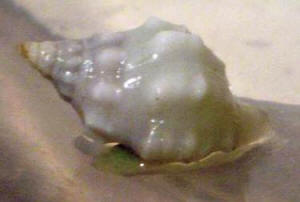 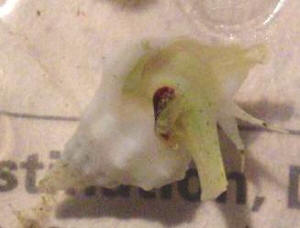 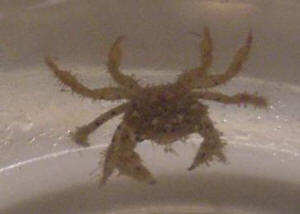
|
|
Fish Compatibility Question Actually 'And
Conch Eggs Too? -- 04/16/10
Eric!
<<Chris!!>>
It's Chris K again
<<Indeed it is! [grin]>>
(I've tried to stay away, but I usually show up again like a
bad penny).
<<Ah'¦no worries my friend>>
I felt like I won the lottery last time we spoke regarding the
blue assessor and possibly being able to add it to my aquarium
with my other fish.
<<Mmm yes, I remember>>
Just to refresh you
<<Thank you for this>>
I have a 90 gallon, with 20 gallon sump and refugium, 4 clowns (2
ocellaris and 2 black and white Percs), 1 yellow tang, 1 flame
angel, 1 Sixline wrasse, 1 Firefish goby and 2 very small neon
gobies (and a few small corals).
<<Ah yes'¦>>
I have discovered another blue fish and I would like to ask you
about its compatibility.
<<Okay>>
It is an ORA tank raised Indigo Dottyback.
<<Mmm'¦>>
I stumbled across it today - it's gorgeous!
<<Indeed>>
From what I am gathering I am afraid of two things - either
it's going to be too mild of a fish to add at this point
considering what I already have in the tank,
<<Always a possibility'¦ Like with the Assessor,
it's my opinion the Sixline will be the biggest problem re
compatibility issues, with the Flame a possible
'short-term' antagonist. And also like with the Assessor,
removing these two for a week or so while the newcomer settles in
can help 'though you may see a reversal of the situation
with the Pseudochromis and the Wrasse upon reintroduction (it may
be classed as 'mild mannered' as Dottybacks
go 'but it is still a Dottyback)>>
OR, it will be best to keep it in a small group which may cause
me to be overstocked.
<<While a group of these in a 'species specific'
display would be stunning 'I certainly don't think
there would be a problem with keeping a single specimen with a
mixed group of fishes>>
What do you think?
<<I think I just told you'¦[grin]>>
Could it be better than a 50% chance?
<<It could well be a better 'risk' here than the
Assessor, yes>>
Hoping for a great big "eureka" here....
<<Do I hear singing?>>
Also - I recently (2-3 weeks ago) purchased a conch - There was
confusion as to whether it was a fighting conch or a queen
conch
<<Hmm'¦a BIG difference, ultimately 'and
either one arguably too big for a 90g>>
- however they charged me for a queen conch
<<But of course they did'¦>>
- .... regardless, lately it has been sitting on a certain rock
and I believe laying eggs (I have attached a photo if you are
able to confirm).
<<Yep, these are egg casings>>
If they are eggs, do they need a male to fertilize them
<<Yes>>
or is it possible that she was "pregnant" when I
purchased her.
<<Considering the newness of the acquisition, this is
likely the case here>>
Is there a chance that these could actually hatch?
<<Sure 'but don't get too excited. The larvae
will be tiny (microscopic even) and planktonic 'I think
it very, very unlikely any would survive the month or so in your
display that it takes before they would settle out 'and
even then they would likely fall prey to the Wrasse (and maybe
Pseudochromis?) in short order>>
I am really not sure what to expect.
<<I would not 'expect' anything much
here>>
Or if there is anything I should do to aid in their survival.
<<Unless you have the resources and equipment, and are
prepared to institute a Conch breeding program, there's
nothing 'to' do>>
Thanks again so much!!
<<Always a pleasure>>
And P.S. I am always inclined to follow up and let you know how
things work out!
<<Most excellent'¦ Be chatting! Eric
Russell>>
|
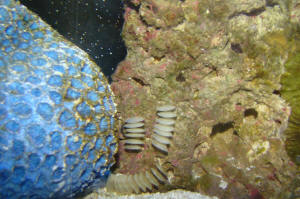 |
|
Re: Fish Compatibility Question Actually 'And
Conch Eggs Too? Conch & Cuke sel. - 04/17/10
Eric!
<<Chris!>>
Yes! You hear singing - fortunately (for everyone else) there are
no mountains near me or I would be singing from the top of
them!
<<Hee-hee!>>
I wonder though... Why did no one at my second favorite LFS
indicate that the conch I was so interested in would be too big
for my aquarium?
<<Mmm well, can't say for sure not knowing them,
but'¦ As for the conch, Strombus alatus needs a 100g+
system with more sand (4' deep or more) than rock for a happy
lifetime'¦Strombus gigas will need likely three times
this volume>>
Actually that's a rhetorical question - I realize that they
want my 20 bucks.
<<Ah!>>
-I read that conches can lay up to half a million eggs at a time
- but it sounds like I am not going to be making my first million
by selling baby conches for $2 a piece at the next frag swap (big
sigh) :)
<<Yeah, I used to think I could finance my hobby by selling
SPS frags locally 'if it were only that easy,
eh?>>
Fortunately, I can take the bad news with the good - eventually I
will need to get rid of the conch, so I am not planning on
getting too attached. I was merely looking for something to keep
my substrate nice and clean. I have gotten past touching crabs,
snails, conches, shrimp... but I am not sure I am ready to handle
the creepiness factor of a sea cucumber,
<<Some are actually quite good sand
sifters/detritivores'¦but don't expect one to keep
your substrate all 'clean and white'>>
and the dreaded "Cuke nuke" frightens me.
<<The more commonly available sand-sifting species (e.g. --
Holothuria hilla or Tiger Tail Sea Cucumber and Holothuria
floridiana or Common Atlantic Sea Cucumber) pose only a small
hazard re, in my opinion. I have kept these since the late
eighties without incident>>
(In case I am being too subtle, (ha-ha) I am fishing for
suggestions here - if you are so inclined,
<<One of the above mentioned Cukes, with some Nassarius and
Cerith snails, and a Brittle Star>>
do feel free to tell me that "Cuke nukes" are over
rated)
<<The potential is always there 'but I have even
heard 'speculation' that in a captive system the toxicity
of these creatures may even decline over time. At any rate, if
the animal is not being 'attacked,' I think you have
small reason for concern with the species mentioned>>
But on the bright side my Sixline wrasse is going to be fat and
happy for a while and.... I think I am going to be getting a
beautiful blue fish to complete my palette, which if memory
serves, brings me to exactly what I was looking for to begin
with! TA DAH!
<<Now how does that saying go'¦oh
yeah'¦'Yes, Virginia [Chris!], there is a Santa
Claus''¦>>
I plan to follow up with you to let you know how things go
<<Great!>>
- your wisdom has been invaluable and your patience with my
unrelenting droning over a blue fish have been positively
inexhaustible.
<<Has been my pleasure>>
I am expecting a good result - and I would like to be able to let
you know that your efforts were not wasted!
<<If only one person ever reads/benefits from 'it
is never wasted. Not to mention the opportunities provided to
expand my own horizons>>
Thanks again - as always!
Chris K
<<Be chatting my friend! Eric Russell>>
|
|
Something Growing on My Rock? Snail Egg Casings --
4/11/10
<Hello Bill, Lynn here today.>
I have a 90 gal salt tank 1 large lion-fish, 1 large eel (yellow
with black dots), 1 large black pointy sea urchin, 4 conch
snails,
<Do you know what variety/species?>
..many Mexican turbo snails, 1 brittle starfish, 1 chocolate
starfish, about 80lbs of rock, water tests good most of the
time.
<Need to aim for all of the time!>
I use a 1200 gph pump with overflow to sump containing miracle
mud and mangroves and a canister filter and turbo twist UV light
and a water chiller for temp with average 78 degrees. Can you
identify what these things are growing off my rock see
picture!
<Yep, they're snail egg casings, possibly left by a
Melongenid (Family Melongenidae), which includes species commonly
referred to as Conchs and Whelks. The casings you have are
definitely not from a Fighting Conch (Strombus alatus or Strombus
pugilis), or a Queen Conch (Lobatus/Strombus gigas), all of which
are in the Family Strombidae. Their egg masses resemble an
amorphous tangle of gelatinous string embedded with sand. Please
see the following links for examples:
Strombus alatus (aka the Florida Fighting Conch): http://www.jaxshells.org/1562anne.htm
Strombus pugilis (aka the West Indian Fighting Conch): http://www.jaxshells.org/1540anne.htm
Here's an example of a Melongenid's egg casings,
specifically Melongena corona (aka the Crown Conch). They're
a bit more rounded than the ones you have, but you can see the
similarity (and they do vary): http://www.jaxshells.org/mcegg3.htm
Here's another Melongenid example, the Channeled Whelk
(Busycotypus canaliculatus). Busycotypus/Busycon species'
casings are similar but usually have a bit more surface texture
(not as smooth): http://www.turtlejournal.com/?m=201002&paged=2
By the way, it looks like you have a nice little population of
beneficial Collonista snails, aka 'Mini-Turbos', roaming
the rocks! You can find more information on these at WWM. Just
enter Collonista in the Google search engine:
http://www.wetwebmedia.com/Googlesearch.htm >
Thanks Bill V
<You're very welcome. Take care, Lynn Zurik>
|
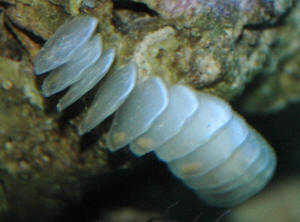 |
Snail questions, Nass. sys., Strombid repro... --
02/12/10
Hi Crew,
I have a 24 gallon Aquapod with live rock, crushed coral and 96w T5. I
originally had sugar like sand but it blew around too much and I could
not adjust the flow properly since there is a limited choice with the
way the Aquapod comes. So I changed to crushed coral and I really like
it. The tank is now up over a year and the crushed coral about 9
months. But I do have one spot in the middle under the rock that still
has some sand.
Recently I got some critters from the Keys. A pair of rusty Gobies and
a Blue Chromis. Not sure how long I can keep the Chromis but right now
he is only 1.5 inches and a beautiful blue. I also got 2 Keyhole
limpets, 4 Astrea snails and 6 Nassarius snails. This was two weeks ago
and they all seem fine except for the Nassarius. Have not seen them
since they went into the tank.
<Likely they have burrowed under the sand/crushed coral here>
This is my third try for them in this tank. Is the crushed coral just
not to their liking or is something else amiss.
<Most members of the genus, family are much better off with finer,
softer substrate>
Aside for the fact that it was hard to get to the sand in middle of the
rock I had hoped it could serve to house the Nassarius. I also have
Stomatella snails and Strombus maculatus.
<Mmm, do investigate this species. Something else as M. maculatus is
often mis-sold...>
But the Nassarius just never make it. I keep trying because I have
nothing else to eat leftover food except for some tiny thread like
worms and I am not even sure what they eat.
<I consider that you have plenty of snails here>
I don't keep any crabs not even hermits because, as you guys say,
they are opportunists.
So what can I keep for that purpose that will not steal from my corals
when I feed them, like the peppermint shrimp that I tried.
<Your own periodic maintenance... vacuuming, water
changes...>
My second question relates to the Strombus. I have 6 that are always
laying their eggs in their capsules all over the place but I have yet
to see one baby. I can see the eggs in the capsule and at some point
there is a hole in the capsules and no more eggs in it. But none seem
to survive.
My Stomatella came as hitchhikers, probably on some coral, and now I
have hundreds of little ones.
Thanks,
Sam
<Could be a few things influencing the Strombid young... chemically,
predation... Bob Fenner>
|
Egg Sacs ID? Tulip Snail -- 1/22/10
Greetings again,
<Hello Steve, Lynn here today.>
Found these egg sacs on a blade of Turtle grass (Thalassia
testudineus) in the Fl. Keys.
<Neat>
Have seen these before and never paid any attention to them. Been
searching the web for hours, haven't found any thing close
helping me on this. You all are some of the most knowledgeable
out there, so I am wondering if anyone of you knows what these
are, or who might.
<It looks like a grouping of Tulip snail (family:
Fasciolariidae, genus: Fasciolaria) egg cases to me. These snails
are very common around Florida so it doesn't surprise me that
you've seen their neat little egg cases before! They're
typically trumpet shaped with fluted tops and narrow stems, and
can be attached to just about anything (rocks, grasses, etc.).
Please see the following links for comparison:
http://www.jaxshells.org/vilano60.htm
http://www.flickr.com/photos/36372157@N05/3377407678/in/photostream/
See the FAQ titled 'Halimeda seeds? 4/13/09' (note
follow-up replies):
http://www.wetwebmedia.com/MolluscPIX/Gastropods/Prosobranch%20PIX/Conchs%20Strombids/ConchF1.htm
>
Thanks for all of your great help! You help all of us in the
Hobby!
<You're very welcome, it's a pleasure!>
Steve
<Take care, LynnZ>
|
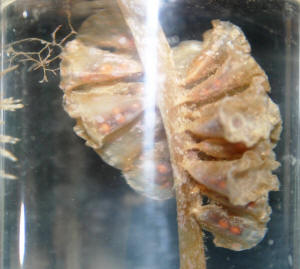 |
Re: How many fish can you put in a 75 gallon tank?, SW
Stocking, now collecting your own snails 12/30/09
Thanks... are snails you find on the beach safe to bring back to put in
the tank?
<Depends on where you live, what type of snail, generally I would
not recommend adding anything to the tank that you are unsure of what
it is.>
To test it out, could you just put it in a QT first?
<I would QT everything, but not sure what QTing will tell you about
the safety of the snails.>
What would a large snail in a good sized conch eat in the tank?
<Whatever you feed it hopefully.>
Thanks, Nick
<Welcome>
<Chris>
Re: How many fish can you put in a 75 gallon tank?, SW
Stocking... Snail sel. 12/31/09
What were finding are snails in conch shells about 2-3 inches long on
the shores of the gulf of Mexico in florida (ft. Myers).
<Snails living in large conch shells or just small conches?>
We look in the early AM for them. They seem to be pretty hardy. Have
you heard of any instances with this sort of thing? People bringing
them back... having them die or live?
Thanks, Nick
<Collection legalities aside, I would not add these to your tank
until you positively identify what snail/conch species you are dealing
with.>
<Chris>
Re: How many fish can you put in a 75 gallon tank?, SW Stocking
12/31/09
With further research... the snails are florida fighting conchs. Do you
know of them?
<http://www.wetwebmedia.com/MolluscPIX/Gastropods/Prosobranch%20PIX/Conchs%20Strombids/ConchF1.htm
>
I see they only grow 2 to 3 inches.
<Can grow twice that.>
So that's a plus compared to the foot long queen conch that I
thought it was.
Thanks, Nick
<Welcome>
<Chris>
Re: How many fish can you put in a 75 gallon tank?, SW
Stocking, Fasciolariids 12/31/09
Also, I have found true tulip snails. They are really neat... but in
captivity, I read they eat clams, mussels, and other meaty food.
<Not just in captivity.>
What do they mean by meaty food?
<They are predatory.>
Do you think that a local fish store would supply that type of
food?
<Sure, just buy lots of snails, the tulip will be happy to eat
them.>
Also, fighting conchs are sold regularly and people say they clean up
well.
However, I was wondering if the tulip would eat them, for the tulip
eats other snails as well.
<Most likely would.>
I just want to know if I can support it in my tank because I leave
tomorrow.
Thanks, Nick
<Welcome>
<Chris>
Re: How many fish can you put in a 75 gallon tank?...
ongoing re Snail sel.... 1/1/10
Okay.. I am still wondering about the tulips... so do they only turn to
the other snails when they are very hungry?
<Read here:
http://wetwebmedia.com/MolluscPIX/Gastropods/Prosobranch%20PIX/Conchs%20Strombids/ConchF1.htm
and the linked files above on Sel.>
And could I buy mussels and or clams at a local supermarket to feed
them, or would that be risky?
<Is not risky... Learn to/use the search tool/indices on WWM>
So my tank is 75g.... how many conchs should go in and what about the
tulips?
Happy New Year!
<Keep reading. Bob Fenner>
Re: How many fish can you put in a 75 gallon tank?, SW
Stocking... Tulip snails... no reading 1/1/10
Okay. well I want to keep it simple.... so I think I will let the
tulips go and keep some conchs.
<If the tulips have been in your tank or exposed to any of your
livestock/live rock it must not be returned to the ocean, either find
them a new home or euthanize them, but do not release them back into
the natural environment.>
The tulips would cause too much trouble for me. I want to have a
friendly tank. I just put my flame back in yesterday, but it still a
little white around its mouth. I was just wondering when I could put in
the 2 royal grammas.
<Grammas are best kept singly.>
Do you have to QT?
<I would.>
There pretty hardy.. aren't they?
<QT is to protect your other fish as much as the ones in QT.>
What would I feed?
<http://www.wetwebmedia.com/grammas.htm >
Ands one more thing... should I do anything with the conchs when I get
home or just put them straight in?
<I would QT them.>
Thanks for all of your help,
Nick
<Welcome.
<Chris>
|
Snail hitchhiker 11/27/09
Could you guys/gals possibly tell me what this is and whether it
is reef safe or not?
<Mmm, looks to be a predatory Fasciolariid species. See
here:
http://wetwebmedia.com/MolluscPIX/Gastropods/Prosobranch%20PIX/Conchs%20Strombids/ConchF1.htm>
The only snails I have in the tank purposely are Astraea,
Margarita, Nerites, Cerith and Nassarius. I don't think this
is any of those. The size is about 0.5 cm at the moment.
Thanks much!
Roxanne
<I'd remove this animal. Bob Fenner>
|
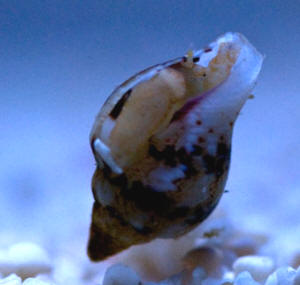 |
|
Please Help with an ID: Strombid - Conch
10/5/09
Dear Crew,
<Hello Justin, Lynn here today.>
A few months ago we were at a new LFS in our area. My wife has a
fascination with conchs, and when she saw these really
interesting spiny shelled "conchs", she just had to
have one. The only problem was, this particular "conch"
as we were sold was a murex snail.
<Oops, Murex can have exquisitely beautiful, ornate shells,
but they're predators.>
Well after a few months, we finally saw the snail feeding on our
fighting conch.
<Ouch>
It was too late for him, and we proceeded to remove the snail to
a 5g tank by himself (my wife couldn't bring herself to get
rid of it).
<Good for her!>
Anyway I got in contact with the LFS, and they did in fact
apologize and offer to replace our conch for their mistake.
<Wow, that's a well-run store.>
Apparently these snails were labeled as "conchs" when
they came in. Anyway we went back yesterday to get a replacement
conch, and we got some kind of what I believe to be a snail that
they said was a conch, and promised it was. Now I am no conch
expert, but to me, this really doesn't look like any conch I
have seen available in the trade.
<There are many varieties and appearance can vary quite a bit
within a given species.>
I was hoping if I could get some help, since I have already had
one predatory snail, I don't really care to have another.
<I can certainly understand that. From what I can see, you do
indeed have another conch -- something within the family
Strombidae ('true' conchs). Unfortunately, given the
number of possibilities, and not knowing the location of origin,
I can't narrow it down any further. My guess is that it's
probably one of the Florida or West Indies species, but again,
with the degree of variation in color, presence/shape/size of
spines/knobs, etc., it's hard to pin down which. It also
appears that your poor little snail received some rough
treatment/wear at some point, whether (naturally) in the wild or
in transit. Note the broken tip of the spire and worn appearance
of some of the protuberances. Please see the following link for
more information and comparison (also take note of links within
regarding specific species):
http://z14.invisionfree.com/Conchologist_Forum/index.php?showtopic=1230
More photos of this family here (worldwide species):
http://www.gastropods.com/Taxon_pages/TN_Family_STROMBIDAE_STROMBINAE.shtml
http://www.idscaro.net/sci/01_coll/plates/gastro/pl_strombidae_4.htm
One thing of note is that you don't usually see conchs up on
the glass or rocks; they normally hang out on or within the
sandbed. However, apparently this sort of behavior isn't
uncommon in juveniles/smaller individuals. I also need to give
you a heads-up if you plan to continue researching this little
snail. There's been quite a bit of taxonomic change in this
family so depending on where you look, you'll find the same
snail species listed under several different genera. For
instance, I've seen a queen conch referred to anything from
Strombus gigas to Lobatus gigas or Eustrombus gigas. It makes for
some confusion, so be ready!>
Thanks Crew!!
<You're very welcome! Enjoy your new addition!>
Justin
<Take care, LynnZ>
|
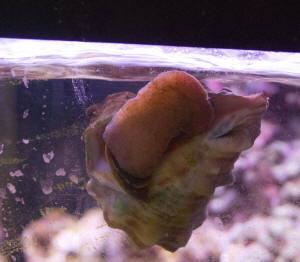 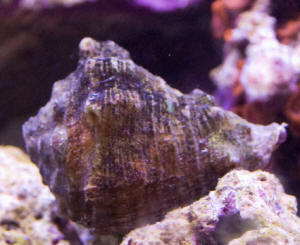 |
|
Re: Something eating my clam 9-12-09
Here are a couple a photo of my Strombid!
<Thank you for sharing. BobF>
|
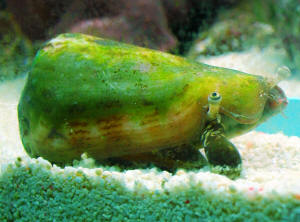 |
Horse Conch: Big Appetite, Potentially Huge Snail --
8/20/09
Hello, I have a young horse conch who of course ate all other snails in
my tank faster than I could find out he is indeed a cannibal (ignorant
me).
<Ouch! Unfortunately that's one of those lessons learned the
hard way to research before bringing home! If what you have is indeed
the Florida horse conch Pleuroploca gigantea (family Fasciolariidae --
tulip snails) it will most definitely eat other snails, some
thin-shelled bivalves such as pen shells (family Pinnidae) as well as
scavenge. In addition, it also has the potential to reach almost two
feet in length - as in yikes!>
I now feed him pieces of shrimp tucked into snail shells. Do you know
if he eats other life such as corals?
<Nope, it should leave your corals alone.>
Thanks for considering my question, Mary
<You're very welcome. Take care, LynnZ>
|
Help With Snail Please: Florida Crown Conch -
6/23/09
<Hello Shelly, Lynn here today>
I have found this large snail...can't find out anything about
it.
<The common name is the Florida Crown Conch, a carnivorous
predator/scavenger that inhabits intertidal/some subtidal areas:
mud flats, oyster beds, estuaries, salt marshes, and such. This
species (Melongena corona) varies considerably in size, color,
and shape, which has unfortunately led to some taxonomic
confusion and debate. The various morphs are generally considered
either one of several species/subspecies within what's known
as the 'Melongena corona complex', or simply as a variant
of the single species: Melongena corona. Please see the following
links for more information:
http://www.sms.si.edu/IRLSpec/Melongena_corona.htm
http://zipcodezoo.com/Key/Animalia/Melongena_Genus.asp
>
I have it in my saltwater tank. It was found at the Ponce inlet
in New Smyrna beach Florida.
<Okay>
I have tried to look it up; I know it is some kind of venomous
cone snail
<No worries, it's not a cone snail or venomous.>
....but it is so prehistoric looking...like nothing I can
research.
<It is indeed an interesting looking snail. Thankfully
there's a lot of available information on the 'net and
elsewhere -- just use the terms above.>
Can you help me identify it or pass me on to someone who can?
<I think we've got it!>
Thank you
<You're very welcome>
Shelly Broussard
<Lynn Zurik>
The picture does not do him justice...he is LARGE!
<Yes, Crown Conchs can apparently get pretty sizeable (up to
~8').>
It has the "shooter" thing that comes out the one hole
on the end of the shell...
<Well, while Melongena species and cone snails both have a
proboscis (long tubular feeding organ), only the cone snail has
the added venomous harpoon-like device. Melongena species'
main diet consists of bivalves and other gastropods/snails
(including each other), dead or dying animals, and possibly
ascidians/tunicates. Harpoon-like devices and fast acting venoms
are handy for capturing and subduing active/struggling prey, but
in the case of Melongena species' prey, it's overkill.
Their main prey items aren't going to suddenly swim away.
These snails typically use their long proboscis to work between
the two halves of a bivalve and feed bit by bit on tissue removed
by means of tiny 'radular' teeth.>
..then like a head and face under that with two
"antenna" things on it. He glides around the tank on
large mass
<The "foot">
that has a hard bottom on it.
<What you may be seeing is the snail's oval operculum
(trap door at the opening of a snail that protects the soft body
inside from predation and desiccation).>
He mostly stays buried in the sand...but when he does move he is
fast!
<That's pretty typical. When they smell food, they erupt
out of the sand!>
I have had him in my tank for over 6 months...and just saw him
kill a fish!!!!
<Yikes! Although healthy/live fish are not usually on the
menu, these are opportunistic snails that will take advantage of
any food opportunity that comes their way. They've got big
appetites and are not picky. You might want to offer your snail a
bit more food -- clams, fish, shrimp, etc., to hopefully deter
further predation. If that doesn't work, you'll need to
remove one or the other to another tank.>
I tried to look him up and found other poisonous cone
snails....sort of like him...but nothing close! If he is
endangered
<Nope, it's a common snail.>
or of scientific use I would like to turn him over to the proper
people. I have been collecting things out of the Indian River and
Atlantic Ocean in the New Smyrna beach area for over 25 years
<I know it's tempting, but we do try to discourage people
from doing this because so many find out too late that
they're unable to care for an animal long term. Also,
collection is regulated or prohibited in many coastal areas. Here
are two links to the new Florida regulations that take effect
July 1:
http://www.floridaconservation.org/RULESANDREGS/Saltwater_Regulations_recharvestmls.htm
http://www.floridaconservation.org/RULESANDREGS/Saltwater_Regulations_recseashells.htm
>
...and have NEVER found anything like this!
Thank you again.
<You're very welcome again! Take care, LynnZ>
|
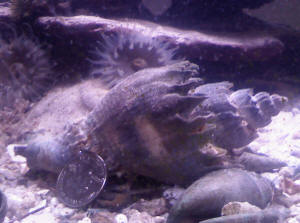 |
|
Halimeda seeds? 4-13-09
Crew,
<Ryan>
I am a long time reader and I truly appreciate the site. I have
two identifications questions for you. The first is a golf ball
sized seed pod looking thing that came attached to a clump of
Halimeda, I have searched
plenty but found nothing about Halimeda seeds or anything of the
seed ball.
<Mmm, no... Halimeda is a Thallophyte (an algae)... reproduce
by spores... true plants (Embryophytes) have seeds>
I have now noticed little green maybe Nudibranchs on the tanks
glass near the seed ball. I just want to check the IDs to be sure
I am not unleashing a plague in my tank. I know I should of
probably not put something in my tank with out knowing what it
exactly what it is but the store didn't think it was a big
deal.
Thanks for the help,
Ryan King
Current Tank setup:
AGE - three months
55 Gallon with 17 lbs live rock and 60 lbs lace.
Lighting is a 65x4 power compact.
30 Gallon sump with about 20 gallons of water in it.
The tank runs at 78F and salinity of 1.024
I used instant ocean salt mix and RO/DI water.
Current stock:
Fish: Yellow Tang and two Ocellaris Clowns
Shrimp: Cleaner, pair of Peppermint
Stars: Blue Star, Brittle Star
Snails: 20 various small cleaners
Crabs: 10 Red Leg hermits, 10 Blue Leg hermits
Coral: Xenia, GSP, Mushroom, and a few misc frags
<Looks to me to be a colonial Ascidian... the clear bunch is
dead... Bob Fenner>
|
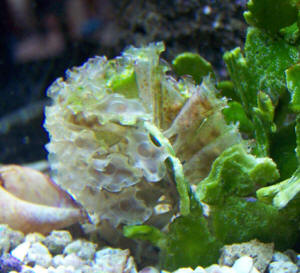
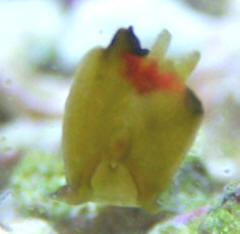 |
|
Correction to today's dailies -
4/13/09
Hiya Bob!
<Mich>
So I was looking at that ID question that came and talked to Lynn
about it this morning. It is definitely not a colonial
Ascidian.
Lynn found these photos:
http://www.jaxshells.org/vilano60.htm
http://www.biol.andrews.edu/EVERGLADES/organisms/invertebrates/mollusks/true
_tulip_snail/egg_cases_of_tulips.jpg
We think it is a snail egg mass, likely that of a tulip snail,
which likely wouldn't be good news for Ryan's tank to
have such carnivorous snails.
http://www.indyzoo.com/pdf/TrueTulipSnail.pdf
<Ohhh!>
And the other image which he thought were Nudibranchs look to be
Acoel flatworms, specifically Convolutriloba, similar to the
photo here:
http://macropyga.googlepages.com/convolutriloba_1.jpg
Which came from this site:
http://macropyga.googlepages.com/
and the differences can be seen here:
http://macropyga.googlepages.com/identification
Lynn found all these images. She's really great at getting
these ID's!
Cheers,
Mich
<Thanks much... Will amend on the morrow... a shame that
I've deleted the original senders email address. BobF>
He wrote back!!!! YAY!!!!! Lynn replied to him. M
<Ahh, very good. B
Re: Halimeda seeds? Egg Capsules and Acoel Flatworms -
4/13/09
Bob,
<Hi Ryan, Lynn here this evening. I sure am glad you wrote
back. My fellow crew member, Mich, and I put our heads together
this morning and came up with some information regarding the two
mystery items in your tank. The follow-up will be posted tomorrow
at the dailies, but I've included a copy here as well (see
below). The only thing I'd like to add is that we've got
lots of information at WWM regarding Convolutriloba flatworms and
Tulip snails in marine systems. Just enter the terms in our
search engine and you should be good to go:
http://www.wetwebmedia.com/WWMAdminSubWebIndex/question_page.htm
.>
Thanks for the info - I guess it shows that I am clearly an
electrical engineer and not a biologist (algae has no seeds...
doh).
<Heeheeee! No worries. I hate to think of the wholesale
Godzilla destruction I could cause if I even stepped a toe into
the world of electrical engineering!>
I do enjoy the site and your book.
<On behalf of Bob and the rest of the crew, I thank
you!>
Best Regards,
Ryan King
<Take care, LynnZ>
|
|
Red Footed Conch Eggs?
12/4/08
Hello All!
<Hello there!>
Love the site, gotten many, many useful hints and tips!
<Excellent>
I've searched your site and elsewhere for any information on
what I believe to be Red Footed Conch eggs, to no avail.
<Red Footed Conch snail is one of the common names usually
associated with Opeatostoma pseudodon, Family Fasciolariidae
(Tulip snails). For more information, please see this link:
http://www.wetwebmedia.com/snailidfaq3.htm >
I've been unable to turn up any info so I'm hoping you
can shed some light.
<I hope so. I found a good photo of a related snail laying
eggs, and another showing a grouping of egg cases. Although the
ones shown are from a different species, they're likely to be
fairly similar to those of your snails. Please see the photos at
this link for comparison:
http://www.deepseaimages.com/dsilibrary/showphoto.php?photo=9517&cat=631
>
A couple of weeks one of my RF Conchs spent an unusual amount of
time in one spot on a piece of live rock. I then began to notice
small patches of about ¼ inch slender bell shaped
opaque objects slowly appearing under the conch as he/she moved
very slowly around the face of the rock. All told there are
around 20 or so covering an area roughly the size of two
quarters.
<Neat! Thank you so much for sharing these observations with
us. By the way, we'd love to see some photos if at all
possible!>
Are these possible eggs of some sort,
<Sure does seem so to me.>
which seems to be the logical answer, and if they are should I
take some care in dealing with them?
<I'd leave them alone and see what develops.>
Thank you in advance for any help.
<You're very welcome. Take care, Lynn>
Re: Red Footed Conch Eggs? Yes!
12/5/08
Lynn, thank you so much, your info was very helpful!
<You're very welcome!>
The snail is identical to "The Thorn Latirus" so that
helps with further research.
<Excellent. I'd hoped that it was the same snail, but you
just never know when it comes to common names.>
This photo
http://www.deepseaimages.com/dsilibrary/showphoto.php?photo=9026
shows eggs that are very similar but not exact, where these are
more triangular mine are more of a bell shape,
<Yep, such differences are to be expected with related
species.>
but certainly confirms my hunch they were in fact eggs of some
sort.
<Yes indeed>
I've included a photo, albeit a bad one, it is the best of
the bad.
<Hey, that's not a bad photo at all �
thank you so much for sending it along. What's important is
that you can see the shape of the eggs and how they're
clustered together. Plus that, considering the fact that I
couldn't find a single photo anywhere of this particular
species� eggs, you did all of us a great
service!>
Thanks again for your help and know the site is very helpful to
noobies and vets alike for the wealth of knowledge we can glean
from your pages!
<On behalf of Bob and the crew, you're very welcome and
thank you! Take care, Lynn>
|
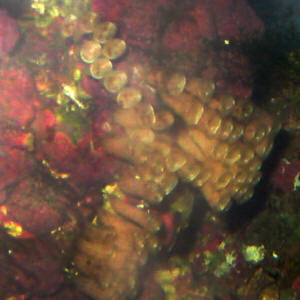 Ah,
yes. RMF Ah,
yes. RMF |
Tankmate for Snowflake Eels and Friends, Tulip/Conch comp.,
-- 10/16/08
I am in a school with three large marine tanks - one 55 gallon predator
(will be expanding to meet the needs of these guys as they grow), one
75 gallon reef tank, and one 500 gallon touch tank. The predator tank
has two snowflake eels (10 - 12") one volatin <Volitans?>
lionfish (5") one Dogface puffer (4") and two wrasse (one
clown and one lunar).
<Better not confuse the predator with the touch tank, hehe. Oh, and
medium sized wrasses have been eaten by larger Echidna eels. You will
need a big upgrade in the not-so-far-away future.>
The touch tank has a beautiful Tulip Snail who has worn out his
welcome. He is unkindly ridding my tank of all the other cleaners!
<Yes very, very predatory. Does best in a one-specimen tank.>
I have considered moving the Tulip to the "predator" tank but
want to be sure he will not be bullied/injured by any of these current
residents or be a threat to them.
<The latter. Wrasses and puffers sleep at night (partly), are still
small and might become prey, even the eels are a little small. In
addition, the puffer would become a threat to the snail, molluscs are
their favourite prey.>
I could use a cleanup crew (even of one) in this tank. The tulip is
quite large 7-8". If he is not suitable for this tank, could you
make other suggestions for cleaners for this tank which won't be
consumed by the predators. What about chocolate chip starfish?
<Would have been among my suggestions if you provide a good water
quality. Can work in your predator tank, just keep the puffer away from
the star for a few hours, he might try to sample it due to its
'new' smell.>
Any other ideas?
<Very well armoured hermits.>
I also would love to try a coral here or there, but "Puff"
(dogface) liked the looks of the rock anemone I recently tried briefly
way too much!
<You can try a mushroom (Corallimorph), they taste nasty and are
disliked my many puffers (not all, though). Another option might be a
photosynthetic gorgonian or a leather coral, if you have reasonable
lighting. However, it cannot be predicted what the puffer will eat and
what he won't eat, they really are individuals with regard too some
of their foods.>
Thanks for your help.
<Welcome. Marco.>
Queen Conch and other Critters Questions
09/13/2005 Hello Bob! <James today> Unlike most aquarist who
are into corals and fishes, I am one of those people who keep crabs,
shrimps, snails, and mantis shrimps. My problem is nobody out there
seems to know the amount of food that they are supposed to be given and
I thought you might be able to help. (1) How often and how much feeding
should Dardanus megistos Hermits who are living in shells the size of
tennis balls be given? How about large Mantis Shrimps (3" to
5") and Boxer Crabs (3" to 5")? <I would step up the
serving. Molting is caused by the animal growing and obviously they are
not. Are you dosing iodine? This helps with the molting process.>
(2) Unlike my shrimps and smaller crabs, my 4" and 5"
shame-faced crabs and mantis have never molted. Is it possible for
crabs and mantis to molt only once a year or not at all? <Yes, as
above> (3) Lastly, I have a few Queen Conch but they don't seem
to be growing. I don't know how fast they are supposed to grow.
I've heard that they will only eat stuff that are only ground, but
mine will eat stuff that are on the LR and glass. I would like to
supplement feed them, but don't know what to give. I don't know
what those people who aquaculture conch feed their conch, but I was
planning to use algae disk. <Most conches will starve to death if
not given enough food. You can try the algae disk or try Nori (freeze
dried algae) and feed in greater amounts than you have been. They also
prefer a sandy bottom. I'll run the question by Mr. Fenner
pertaining to "what aquaculture places feed conches. James (Salty
Dog)> Thanks! Re: Queen Conch and other Critters Questions
09/13/2005 Bob, any idea what aquaculture places feed conches?
Thanks, Salty <Mmm, nope... maybe here: http://www.google.com/search?sourceid=navclient&ie=UTF-8&rls=GGLD,GGLD:2004-27,GGLD:en&q=aquaculture+foods+for+conches
BobF>
Strombids, Culture, Contacts Bob, just curious, could you
forward any contacts involved in/knowledgeable about the aquaculture of
Queen Conch (Strombus gigas) from reproduction through larval
metamorphosis to adult. Thanks, Chris <Nothing current in my files
at home, but someone from the Philippines wrote me recently re Strombid
use and his email addr. is attached to the corr. on the WWM site...
current FAQs or posted to marine gastropods... and Frank Hoff should be
contacted for the best folks to find NOW in the field.... You can find
his firm's contact information in a recent issue of FAMA... and
maybe ORA/Harbor Marine, Bill Addison/Dave Palmer... If it were me...
I'd get on down to the college library, do a quick computer search
and send out a few emails asking this same question to folks who've
recently written (ha, recently) in the field. Bob Fenner>
Strombus species? Hello Mr. Fenner, I have read most of your
articles and am a great fan of yours. I have a question regarding these
algae eating snails which is abundant in our country (Philippines) as
food! <Yes, have eaten them there> I have obtained a book about
Philippine shells and the family Strombidae is said to be a herbivorous
group. <Principally, yes> I have seen on the market...Lambis
truncata sebae, Lambis wheelwrighti, scorpius, millepeda and so on.
also Strombus lengtiginosus, aurisdianae, aratrum and so on. my sand is
turning brown, my question is, will they be fine for cleaning algae in
my sandbed? <As young, yes...> wont they eat the worms too?
<Some, not too many> will they produce lots of slime on the tank?
<Not a concern in adequately circulated, filtered systems> am
going to purchase these from the wet market, will they be able to
survive long hours without water? <In dark containers with material
to keep them moist, yes, for a few to several hours. Better shipped
this way than underwater in sealed containers> pls send email to:
thanks, Jonathan <Strombids are occasionally used as marine
scavengers in a few markets internationally. Mainly as small(2-5 cm.)
individuals. Most species can get too big for small marine aquarium
use. Bob Fenner>
Re: Strombus species? Hello again Bob, from your previous
reply, you said these are used only when small. I have about 3 inches
from head to foot Lambis species, is this not good for my sandbed? what
other options do I have or what other inverts will stir sand and not
sift? thanks, hope to hear from you soon. <Useful size is a
"relative term"... as to the size, layout of your systems...
larger Strombids can knock over rocks, corals... all are good for their
"scavenging" sand sifting action. Many other animals (fish,
non-fish are good sand stirrers/sifters as well) see the review on
www.wetwebmedia.com. For larger systems the smaller species of Mullids
are my favorite choices (Goatfishes). Bob Fenner>
Queen Conch Bob, Thanks very much for your previous help. It
was so good that I'm going to ask for more. In your text on tank
maintenance you seem to strongly advocate the Queen Conch. Below is
your quote. "Tank cultured queen conchs, Strombus gigas are
available for use in marine aquariums; suitably sized individuals
scrounge around and through the substrate (and sides to a lesser
extent), removing epiphytic green algae and diatom scums. Unlike their
freshwater brethren, conchs will not "reproduce like rabbits"
in your tank; but can reach a prodigious size of ten inches in the
wild." My question is where? Where can I buy a Strombus Gigas. I
have searched the web diligently and found one site that carries these
animals. It sounds ok but there's a problem. The Conch is $6.00.
Then there is the box charge and heat pad charge and probably a packing
charge for all I know. But the thing that's a deal breaker is a
minimum $48 shipping charge. No way at all! <Mail order?... I would
contact the folks listed on the website: www.WetWebMedia.com on the
Links Pages there... they have email... and ask what price they would
charge... they're available but must be bought in "box
lots" to make sense economically...> Can you point me to some
other sources? <Frank Hoff, C-Quest, ORA... but don't think they
sell to the "end-user" at all... once again, a matter of
volume/cost/expedients... If you have a large volume retailer nearby,
they might be able to combine an order with other livestock from one of
these sources/breeders... Clownfishes, Gobiosoma, Pseudochromids...>
Thanks... Jim Griffin <Bob Fenner>
" Horse Conch" ?? Hi I was recently in Florida and
picked up a shell that contains what people have told me is a horse
conch. I'd like to know if that is indeed what I have. I will try
to describe it to the best of my ability. The shell is a dark brown,
spiral about 4 1/2 inches in length. The conch inside of the shell is
an orange color. I found it on the shore in a sandy area with seagrass
the had washed up. I understand that these creatures could grow quite
large, perhaps 2 ft.? I've also been told that they are algae
eaters. Other than the fact that it lives in salt water I know nothing
else. Anything you could tell me would be appreciated. Thanks much
>> Might well be a Florida Horse Conch, Pleuropoca
gigantea... These are decidedly more spiral and long (conical) than
the "other" tropical west Atlantic Conch species (genus
Strombus)... Common in Bahamas and Florida... live in seagrass beds as
young, deeper water for adults (DeLoach & Humann). Principally
algivores, will take commercial prepared foods like tablets that are
algae-based, as well as bits of fish and mussel. (Baensch Mar. Atlas
2). Bob Fenner, who knows that people sometimes keep cultured Queen
Conchs (S. gigas) for algae control... as young, and in large
systems... but has no experience with Horse Conchs.
Fighting conch vs. DSB - Strombus alatus 6/22/03 Hey Gang!
shouting "howdy" from Denver! <right back atcha Tex!>
Anthony, the LFS sold me a fighting conch after I asked for something
to keep a sand bed stirred up. The little conch disappeared under the
sand. Did the LFS sell me a good DSB critter or? <perhaps... this
Strombus species grows medium large (4-5"... or 10+ cm) and is
rather clumsy in the reef. Like all Strombids, they do not fare well in
tanks with a lot of rock and need enormous amounts of deep live sand to
survive long term (say 100 gall mostly sand 6"+ for lifetime).
They eat both algae and meaty fare... rarely if even bother cnidarians
and are fairly good at aerating sand> They said it would get about
the size of my fist, but would take quite a while for it to get there.
<agreed> Also, I got a great deal ($45) on another 70 gallon tank
with a double iron stand, while I've been thinking 'bout a lion
fish to put in there, I've also been wondering if it would be
overkill to put the 70 gallon reef display over the 70 gallon, if I
turned it into fuge/sump. <actually sounds cool for stability if the
fish 70 is not overfed... and lions are large but infrequent feeders.
Could work nicely> Having a great day & hope you are as well!
Stormbringer <to you in kind my friend. Anthony>
Conch Craving Dear Mr. Fenner, I love your website.
<Actually- Scott F. here tonight, but will pass on the kudos to Bob!
Glad you enjoy the site!> I recently checked out your article on
conch snails and I thought you had some cool pictures. I currently own
a milk conch, it is about 3 inches long. How big do they get and what
is the best food and best way to feed them? <Unfortunately, I am not
familiar with this common name, so I cannot provide you with a specific
answer here. In general, most Strombus species can range in size from 2
to 12 inches, so a positive species ID would help. As far as feeding is
concerned- if the species in question is a Strombus variety, then they
mainly subsist on algae, detritus, and just about anything that they
can find-great scavengers.> Also where can I purchase a large queen
conch? I would like it to be about six inches when I buy it. Do you
know anybody who sells queen conches that large? I am really interested
in obtaining a large queen. Please respond soon. Thank you for your
help. <Well, there are a number of good sources out there on the
'net that can provide you with aquacultured specimens. I suggest
starting with two of our sponsors, Marine Center and Live Aquaria, both
of which offer specimens from time to time, or may be able to get them
for you. These guys can reach about one foot in length, so a large tank
is mandatory! They may or may not be able to get you a
six-incher...you'll just have to do a little searching here.>
P.S. I really like your site. <Really glad to hear that! Thanks so
much for stopping by! Regards, Scott F>
Conchs, Scallops and a 20 Gallon Tank...Not Enough Research
Beforehand - 08/25/06 Hello, <<Howdy>> I'm new to
the site and the marine world. <<Ah, welcome....>> I have a
20g that has been running for 2 months now. In this time I slowly added
2 queen conch snails, <<This tank is woefully too small for even
one of these gastropods. They will grow (if they don't starve
first) to more than 6" (12" in the wild) and require a tank
with a mature substrate/live rock of some 75+ gallons...each...for
their long-term survival>> a coral shrimp, 3 blue hermit crabs, a
feather duster, and a flaming scallop. <<The scallop is another
poor choice my friend...will starve to death within weeks to months.
Please learn to research your purchases
"beforehand"...believe me, you and the hobby will be better
off/happier if you learn to pick livestock you have a chance of keeping
alive>> All has been going good until today.
<<Mmm...>> Well, it is still going good, but I found one of
the snails on its back and inside its shell. <<Not a good sign,
these snails have the ability to "right themselves" very
easily>> I moved it and put it upright. Now it is acting as if it
has seen a ghost. It'll take a look around and then goes right back
in. It has not moved from the spot I put him. <<likely something
environmental is malaffecting the conch...your system is awfully
"new"...>> Also, the weird thing is as it did look
around it picked up some rocks and built what looks like a sac with
rocks covering it. I was looking around online about the reproduction
of these snail and these guys are way too young to even think about
that. That is if those sites are right about the reproduction of a
queen conch. Or, that they are queen conchs to start with.
<<Indeed...several species of Strombus available to the
hobby...with Strombus alatus (Florida Fighting Conch) and Strombus
gigas (Queen Conch) being the most readily available>> No one
else in the tank is acting weird. So, could this be that it is
reproducing or dying? <<My guess would be the latter>> Or,
is it just sick? <<Will yield the same result>> Thank you
for your time, Brian <<A little more reading/researching and a
little less buying for now my friend. Regards, EricR>>
To conch, or not to conch.... Most times, not
-- 1/26/08 Hey gang. I have searched through the vast pages of
articles and FAQ's on gastropods, but I can't find a strong
opinion on the role that a conch (be it a queen or florida fighting)
might play in a reef tank setup. <Plowing about, knocking stuff
over...> Is it beneficial to have the sand turned over by something
such as this? <Can be... in some "settings". But for most,
no. Other techniques, approaches are better in the vast majority of
circumstances.> I have been under the impression that it's best
to leave sand as it lays, as the lower layers hold different types of
nitrifying bacteria. Am I completely wrong in this line of thinking?
<Mmm... better to "stir" a bit for most set-ups...>
Thanks again for depriving me of sleep as I stay up too late reading
old FAQ's, -wuf <Please stay up a bit more reading here:
http://wetwebmedia.com/substclng.htm and the linked files...
BobF>
Question re Conch snails Hi, I am trying to
find out if a crown conch will eat a feather duster? Thank you.
<long story short... yes, quite possible. Even likely in some cases.
Conch snails in general are voracious omnivores... and some are
outright impressive predators, decimating worm and mollusk (even other
"snails"). There are very few herbivorous exceptions to this
general rule (like the queen conch). Conch are too large and or
disruptive for invertebrate aquaria in my opinion across the board. Not
recommended for reef aquaria but can be great for fish only. Anthony
Calfo>
No tip-toeing with this tulip... boot his butt out! predatory
snail 8/5/03 Hello WWM folks, <Whassup buttercup> Long time
listener, first time caller. <Excellent... welcome to the Lithium
Network! You're on caller...> Ahem. Many months ago, I added
some live rock to the system. Lo and behold, an interesting hitchhiker
came along too, though it appeared innocent enough--a small brown snail
with a periscope like proboscis. <a hitchhiker got into your tank
from un-quarantined rock... Noooo way?! <G> Ahem> The novelty
of this creature disappeared in about three minutes, and I soon forgot
about it. <we'll call you Rainman> In fact, I assumed that it
died, since I hadn't seen it in many months. Over the past week
I've added several turbo snails to the tank in an effort to control
the diatoms. I noticed that all of a sudden my periscope wielding
hitchhiker reappeared after this addition, and became quite active. I
came home from work today, and saw the "innocent" hitchhiker
was attached triumphantly over an up-turned (dead) turbo-snail. Any
idea of what this guy is? <yep... a Tulip snail or the like> I
took a picture of him before his execution, which is attached below.
<a fine pic> Perhaps he just came upon the turbo snail after it
died, but that's really convenient, now isn't it? <... and
OJ didn't do it> By the way, he was a small rascal--2" long
at the most. <Tulips are voracious predators. Do compare the
shell-shape to the pic on the bottom of page 201 of your NMA RI
book> Regards, Chris Stuhlmueller <kindly, Anthony>
Mollusk Mania! (Snail Compatibility> Dear WWM Crew,
<Scott F. your Crew member this afternoon!> I have a 120 gallon
Fish and Invert Tank, well one invert, and that's a 2" Tiger
Cowries. I would like to add a conch of some sort, however I am aware
that many conches are omnivorous and if given the chance will even eat
other snails. Is there a conch that would not eat my Cowries? Thanks in
advance ~ Justin <Well, Justin, I'd say that you could be
reasonably safe with the rather common, yet ominously named
"Fighting Conch", Strombus alatus, which is mainly an
herbivore. Do a bit more research on the WWM site to find other
suitable species, and don't forget to check out Bob and
Anthony's "Reef Invertebrates", which has lots of
information on all kinds of Mollusks!> P.S. On a side note I
appreciate you guys so much for the work you do in educating marine
hobbyists. It's wonderful to have a source of honest reliable
information, it seems it is otherwise hard to come by. <Thank you
very much for the kind words, Justin! Honest reliable information is
what the WWM site is all about! We hope that you continue to enjoy the
site and grow in your hobby, while sharing your experiences with others
along the way! Good luck! Regards, Scott F>
Snail eating a clown? 09/04/03 <Hello, PF with
you tonight> While doing a check on my aquarium this weekend I
discovered that one of my small clown fish was missing. After searching
the whole tank I discovered him being consumed by a couple of my conch
snails. Both the clown and the snails are roughly the same size. My
question is do you think that the clown died (?) and then the snails
sat down for dinner or is it possible that the snails killed the clown?
<It's a definite maybe. Some snails are predatory, but then
again, they may well have found a casualty and where cleaning it up.
Unfortunately, the only advice I can give is to watch them, and if your
tank parameters are fine, but you have continued fish disappearances, I
would then suspect them.>
Tulip snail 12/12/03 Hello... Love your website and all the
questions and answers. <thanks kindly> Wondering if you could
help me as far as I think I have a Tulip snail, large red snail about 4
to 5 inches long, and I do not know what to feed it?. <they are
predaceous... offer meaty foods of marine origin and be careful of
letting other snails nearby... they are fair game for this snail -
yikes!> I think it ate one of my smaller snails and now he has been
buried down in the substrate for a few days. <you can be sure of
it> How often do they require a large meal and of what kind? thanks
and look forwarded to your reply... Tony <feeding several times
weekly will be fine. Please do take the time to read more about
predatory gastropods in our wetwebmedia.com archives. Best regards,
Anthony>
Fighting Conch? (I'm Doubtful) - 03/09/06 Hello WWM Crew,
<<Hello Glovanna>> Just a quick question. I was needing
some more algae eating snails for my 55 gal. tank. My son in law
brought me several turbo snails, 1 Mexican turbo snail, and then a few
days later he came over with a Fighting Conch snail. The LFS guy told
him that it's an algae eater and safe in a reef tank. <<True,
for the most part...if this is in fact a Fighting Conch (Strombus
alatus).>> After quarantine, I added the snail to my tank about a
week ago. Almost every morning, I've found the Fighting Conch
latched onto a turbo snail. <<And the suspicion starts to
build...>> This morning he was latched onto a bumblebee snail.
I'm having a hard time believing that this Fighting Conch is eating
snails that have died. <<Me too>> As a matter of fact,
after leaving the bumblebee ( dead now for sure ), he is now latched on
to my large Mexican Turbo snail, which was not dead earlier this
morning! <<Time to ditch the conch!>> I actually had my son
in law return the Fighting Conch to the LFS a couple of days ago, where
he was told that the fighting conch would only eat a snail after it was
already dead. Then he was shown a tank full of Turbos with 1 Fighting
Conch and was told that they've never lost a snail to the Conch in
that tank. <<I'll wager what you have is not Strombus alatus,
but quite possibly is a Crown Conch (Melongena corona ). If so, these
can be quite predatory on snails. Of course this is all speculation
with a sharp close-up photo to view.>> All I can go by is what
I'm seeing this snail do in my tank. I don't have a picture of
the snail, but it is large, probably 4 inches from tip to tip. Its
shell is orange in color. Its foot is also orange in color. I've
never seen its "mouth" like you do with Turbos when
they're grazing. <<Mmm, no...Fighting Conchs have a
protruding "snout" with which they feed...you should see
this, and eye stalks, from time to time.>> It has occasionally
climbed onto the glass where a mouth should have been able to be seen.
Have you ever had any experience or heard of this snail being a
predatory snail? <<While it is a possibility,
"Fighting" conchs are not considered snail predators. I think
you have something else.>> Waiting eagerly for your answer, so
I'll know whether this is all in my head, or if he should be
removed immediately! <<Whether this is S. alatus or not, based on
your information I would remove it (for good) if you wish to keep your
snail population.>> Thank you, Glovanna <<Quite welcome,
EricR>>
Sand Sifters for 75 -- 10/10/08 Crew, I have a
standard 75 reef, that is now stocked with some Zoanthid and LPSs
frags, a pair of ocellaris clowns, a mandarin, sand sifting star, sand
sifting cucumber, and 4 Mithrax crabs. I have a small diatom algae
problem, and my two refugiums with Chaeto and a DSB seem to be helping,
but there is still some diatom on the sand. I bought the cucumber to
turn sand, but i cant imagine him being able to turn all the sand in
the 75. I am basically looking for a sand sifter that won't compete
with the star or mandarin and have a detrimental effect on their
health. I have a few ideas for this and would like to know your input.
Saltwaterfish.com has a conch called a Little Bear Conch
http://www.saltwaterfish.com/site_11_03/product_info.php?products_id=2943&parent_category=4&category_search=63&root_parent_id=4.
<Ah, Strombus urceus...> I know conchs have a reputation for
plowing frags but are also great sand sifters. Is he worth the risk??
<Mmm, IMO, sure> I was also think about? a diamond goby, but
again I don't want the mandarin or sand sifter to starve. <You
are wise to consider this possibility> I was also thinking about
adding about 20 Nassarius snails, how will they do?? <They are
prodigious workers... Another worthy trial> I have 110 lbs of LR and
about 4 inches of sand. I was hoping that the refugiums and LR would
provide enough food. Thank you? for your help. Zach <I'd be
inclined to try the small Strombid first here... as well as look
further into the likely sources of the Diatom issue...:
http://www.wetwebmedia.com/brownalgcontfaqs.htm and the linked files in
the series above. Do you have "something" too available
through your source water? Low RedOx? Perhaps a change in the
macroalgae cultured in your refugiums? The addition of or adding to a
DSB... Bob Fenner>
Re: Sand Sifters for 75 10/11/08
Bob will a fighting conch have the same effect as the little bear? I
know they get a little bigger will this become a problem or will
results be the same as the Little Bear?
?Zach
<Let me skip ahead here and re-state that I'm not a fan of
using/housing Strombids of any size in most marine aquariums...
BobF>
| Snail Identification: Likely Horse Conch -
2/2/08 Hi all, <Hi Jenn!> Just a quick thank you for all
the information and first hand knowledge you provide to SW
hobbyists! <You're very welcome! It's a pleasure!> I
have searched your site for the answer to what type of snails we
have in our 75 gallon reef tank. We bought them not long after we
started our tank, a little over a year ago. They are pink bodied.
They do not seem to be aggressive on algae or other waste. I am
also including a few pictures of the snails for identification.
<Thank you for sending multiple angles by the way, that really
helps. Your snail looks like what's commonly called a Horse
Conch, which is in the family: Fasciolariidae. The snails in this
family are predatory towards other molluscs and will scavenge dead
or dying organisms. Have you noticed any other snails missing?
Horse conchs (likely yours is in the genus
Pleuroploca/Triplofuscus) range in soft body color from orange to a
dark red. Please see the snail at this link, just past halfway down
(Florida Horse Conch) for comparison:
http://h2ocreatures.com/mollusks.html .> We are looking to
continue to build our reef with additional LR and also want to get
a hardworking cleanup crew. Suggestions would be great. <Sorry,
would need to know what other livestock you have, what type of
clean-up you need.> Thanks for your help! Jenn H Central PA
<You're very welcome! Take care. --Lynn> |
|
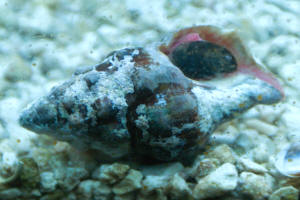
|
| Marine Snail Identification: Likely Fighting
Conch - 3/21/08 <Hi there, Steve> Thanks for the site.
and on to my question. <Okay, let's get to it!> I've
had a snail in my tank since I started it back in April of last
year. I just had someone point out to me that they thought it was a
tulip snail <Good news - it's not!> and that he would eat
other inverts in the tank. <Nope, they're safe.> I
browsed your Marine Snails FAQs and spotted something that sort of
matches my guy but not 100%. Can you give me your thoughts from the
photo?? <It looks to be a harmless/beneficial Strombid, likely
Strombus alatus, aka the 'Fighting' Conch or similar. These
are good sand stirrers and mainly herbivorous, but may also take
meatier fare.> He has eye stalks and a large snout? that he
pushes out whenever I see him above the sand bed. <That's
very typical of Fighting Conchs. Sometimes all you'll see are
just the two eye stalks protruding out of the sand!> He
wasn't being helpful when I took the photo.. <Heheee!
Isn't that annoying!> Most of the time he's digging
around in the sand bed and will disappear for weeks at a time.
<Also typical of Fighting Conchs.> If he is in fact a Tulip
Snail I have never seen him going after other inverts. Is this
something that will occur when he increases in size?? <Nope,
this little guy won't go after your other invertebrates/fishes
- even when he's not so little! Speaking of which, they get up
to about 4" or so in length. These Strombids do, however, need
lots of open areas of DSB to survive long term.> He doesn't
climb the live rock or tank sides. Just stays in the sand. <Yep,
again, that's typical for these. All in all, they're neat
little snails. Please see the following sites for photos and more
information http://www.wetwebmedia.com/gastroart2.htm
http://www.gastropods.com/9/Shell_1329.html (Strombus alatus)
http://www.pirx.com/gallery/mollusks > Love the site and thanks
for you thoughts.. <You're most welcome! Take care,
-Lynn> |
|

|
| Help ID This Snail Or Whelk!!!!...Umm, Is A
Conch! -- 09/26/07 Hi guys! <<Hey Amie!>> I
absolutely love your site! <<Thanks! Is quite the collective
effort>> Okay, here's my problem, I don't know what
this creature is. <<I believe I do'¦>> We
found him and many, many others while snorkeling in the Gulf of
Mexico this past week, some quite large. <<Indeed>>
Actually, to give a precise area, on the bay side of Cape San Blas,
Florida. <<Yes, this animal can be found along all of
Florida's coast'¦and beyond>> We brought 5-6 of
them home (each one approx. 2 inches long) b/c we thought that they
were Turbos. <<Not even close I'm afraid>> (I know,
not very smart) So now we are nervous as we don't know if these
guys are a danger to our fish or reef. <<Not so much to
healthy fish 'but are a danger, yes>> Does anyone
know what exactly these guys are? Some sort of whelk, snail, or
conch? <<Is the latter 'more specifically, the Crown
Conch (Melongena corona). These gastropods are
carnivorous 'and while they would do a good job cleaning
up dead/dying animals and leftover meaty foodstuffs, they will also
prey on your other snails, substrate biota, and possibly sessile
invertebrates as they will surely not get enough to eat as they
grow too large for your system>> Thanks so much for ANY help,
it is greatly appreciated. Kindest Regards, Amie <<Is a
pleasure to assist. Eric Russell>> |
|

|
| Snail ID 2/3/06 Hello Crew, <Roger> I'm on
your website every day -- several times a day, in fact -- hungry to
learn more about the new and interesting little creatures I find
crawling, swimming, jumping, popping, and sliding around my our
newly cycled 150. I'm going to have to pick up 'The
Conscientious Aquarist' from somewhere 'sounds like an
exceptionally great resource to have on hand. <Is worthwhile...
if I don't (and don't) mind stating so myself> My
question is regarding a little stowaway snail I found last night as
I was placing new some live rock with some lovely softies attached.
I'd really like to know what he is. He is about
¼' from tip to tip; his picture is attached.
Currently he's still in QT, until I know more about him.
Hopefully he's benign, and not some species of bivalve killer
because he certainly is beautiful (the picture hardly does him
justice), and we would like to put some captive-bred (Tridacna
spp.) clams in the live sand in the near future. <Mmm, I would
remove this animal... perhaps a member of the Fasciolariidae...:
http://www.google.com/custom?q=tulip+snail+family&sitesearch=wetwebmedia.com
Too likely to be predaceous here> Tank parameters: Size: 150
gallons XH (LWH: 48' x 24' x 30') Live Rock: 80 lb (so
far); intend to reach about 150 lbs total. Lighting: 2 x 250W Metal
Halide, 4 x 96W Actinic, 4 LED 'moon lights' on
Dawn/Midday/Dusk cycle -- 2 hours dawn/dusk; 9 hour midday.
Filtration: Coralife 220 SuperSkimmer Circulation: 3 x MaxiJet 1200
on a wave timer Specific Gravity: 1.023 Temp: 76F (early morning)
-- 79F (when metal halides shut down) dKH: 9 pH: 8.2 Nitrite: 0
Nitrate: 0 Ammonia/Ammonium: 0 Inhabitants: 4 hermit crabs 6 Astrea
Snails 1 Orange Skunk Clown 4 Green Chromis 1 (as yet unseen)
Pistol Shrimp or Mantis 'I'm going to put out some
food and watch this weekend to hopefully confirm an ID. 1 unknown
banded 'telescoping' worm that lives under one of the rocks
<Heee! Likely harmless... Ophiuroid> 4 colonies of Green Star
Polyps (Pachyclavularia sp) 1 colony of Zoanthids 2 Anthelia
colonies 1 Colt (Alcyonium sp.) 2 Mushroom colonies (Discosoma sp.)
<Bob Fenner> |
|
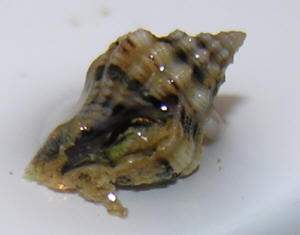
|
| Identification question 3/25/06 Good Afternoon Crew,
Please could you offer me an opinion as to what my latest
'clean up crew' purchase is? It was sold as a 'Red Sand
Sifting Conch', but doesn't look like the ones in a Marine
World article this month as the shell is more pointed. After
looking around the old FAQs and info pages, Strombus alatus, the
strangely named 'Florida fighting conch' looks the best
match - but what do you think. <This is almost assuredly what
this is> Apologies for the slightly bleached out pictures. Thank
you in advance. Bob Mehen, Cornwall, England <"What's
in a name?" Bob Fenner> |
|
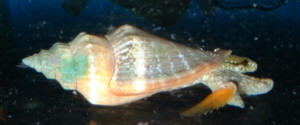
|
| Snail ID Hey Bob/Pete Its a little tough to
ID with that bugger covered in coralline <G> The spike sure
is distinguishing if they all have it (not an anomaly with this one
I assume?) I don't see how this is/could be a conch species...
really does not look the part to me. IMO... it looks Nassariidae.
Its behavior and shape (and what little pattern there is to the
shell still resembles the bands of mud snails variously). Bob...
have you sent this image to Marty B at Tideline? Do you think he
might recognize it? Anthony |
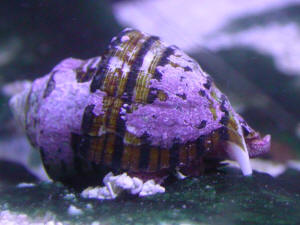 |
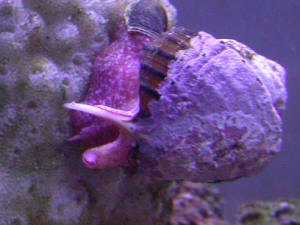 |
| "Red Footed Conchs", prev. snail ID Hi Bob,
This is John Phillips at the Abbey. How goes the struggle? <Fine
John, great to hear from you. I trust you're still playing the
harp, keeping things going there with Marty.B> Sorry for not
getting in touch, but I'm always behind in just about every
facet of my life & certainly not the efficient correspondent
that Marty is; however, I am being somewhat punctual and efficient
regarding this e-mail because it involves taxonomy about a
particular shell that I am familiar with. The common name of your
shell is "The Thorn Latirus", which stems from the very
gaudy and menacing spine/thorn that grows out from the bottom of
its outer lip. It is a member of the Molluscan Family
Fasciolariidae and goes by the 'handle' Opeatostoma
pseudodon and was first noticed and officially/scientifically
described by a chap named Burrow in 1815. It hails from a broad
range of miles stretching from Peru in South America north as far
as northern Baja Calif., W. Mexico. Lives in shallow water and
prefers haunting stony corals, rocks, and boulders. Not a good
thing to accidentally kick with the end of your big toe kissing the
menacing tip of its thorn!! Not poisonous however!! Hope this
trivia proves useful & always a pleasure to provide same. Best
to you and your lovely wifelet & we shall get together again
soon for some chuckles. Cheers from TIDELINE JOHNNY
<Outstanding. Thank you John. Will archive your response with
the pix. Best to you. Bob Fenner> |
Queen Conch and other Critters Questions 09/13/2005 Hello
Bob! <James today> Unlike most aquarist who are into corals and
fishes, I am one of those people who keep crabs, shrimps, snails, and
mantis shrimps. My problem is nobody out there seems to know the amount
of food that they are supposed to be given and I thought you might be
able to help. (1) How often and how much feeding should Dardanus
megistos Hermits who are living in shells the size of tennis balls be
given? How about large Mantis Shrimps (3" to 5") and Boxer
Crabs (3" to 5")? <I would step up the serving. Molting is
caused by the animal growing and obviously they are not. Are you dosing
iodine? This helps with the molting process.> (2) Unlike my shrimps
and smaller crabs, my 4" and 5" shame-faced crabs and mantis
have never molted. Is it possible for crabs and mantis to molt only
once a year or not at all? <Yes, as above> (3) Lastly, I have a
few Queen Conch but they don't seem to be growing. I don't know
how fast they are supposed to grow. I've heard that they will only
eat stuff that are only ground, but mine will eat stuff that are on the
LR and glass. I would like to supplement feed them, but don't know
what to give. I don't know what those people who aquaculture conch
feed their conch, but I was planning to use algae disk. <Most
conches will starve to death if not given enough food. You can try the
algae disk or try Nori (freeze dried algae) and feed in greater amounts
than you have been. They also prefer a sandy bottom. I'll run the
question by Mr. Fenner pertaining to "what aquaculture places feed
conches. James (Salty Dog)> Thanks! Re: Queen Conch and other
Critters Questions 09/13/2005 Bob, any idea what aquaculture places
feed conches? Thanks, Salty <Mmm, nope... maybe here: http://www.google.com/search?sourceid=navclient&ie=UTF-8&rls=GGLD,GGLD:2004-27,GGLD:en&q=aquaculture+foods+for+conches
BobF>
Re: Queen Conch and other Critters Questions 09/13/2005
Thanks James!<You're welcome> I'm not dosing iodine, just
calcium. My Kent Iodine say's 2 drops per 60 gallon. I'm too
scared that it'll kill it. <No worries Gus> I've been
feeding the crabs, hermits, and mantis mostly one cube (per animal) of
Ocean Nutrition Formula One a day. I give them one cube of something
else every few days just for variety. They finish everything and seem
to be hungry all the time (especially the hermit). The conchs are
definitely larger than when I got them 6 months ago, but I'd expect
them to double in size. I'd say they grow about 20%...now at around
1.5". <Gus read here for more info. http://www.wetwebmedia.com/gastropo.htm James (Salty
Dog)>
| Predatory snail (Tulip) 3/27/03 First
off...awesome site...VERY helpful <thanks kindly> I found
this guy in my tank about a week or two ago...didn't get a
picture at the time and I was having a hard time identifying him.
Came home tonight and he seems to have killed one of my Astraea
snails and is chowing down. <indeed... this is a predatory
snail> He seems to be a cone snail of some kind...just trying to
figure out if he should be removed or not. <do remove... but not
a cone at all... it appears to be a tulip snail> These
aren't great pictures (still trying to figure out how to get a
decent shot of something in a fish tank) Thoughts? Thanks very much
for you help Joe <this is a hardy snail and great scavenger for
fish tanks but is not to be trusted with invertebrates. Best
regards, Anthony> |
 |
Fighting conch vs. DSB - Strombus alatus 6/22/03 Hey Gang!
shouting "howdy" from Denver! <right back atcha Tex!>
Anthony, the LFS sold me a fighting conch after I asked for something
to keep a sand bed stirred up. The little conch disappeared under the
sand. Did the LFS sell me a good DSB critter or? <perhaps... this
Strombus species grows medium large (4-5"... or 10+ cm) and is
rather clumsy in the reef. Like all Strombids, they do not fare well in
tanks with a lot of rock and need enormous amounts of deep live sand to
survive long term (say 100 gall mostly sand 6"+ for lifetime).
They eat both algae and meaty fare... rarely if even bother cnidarians
and are fairly good at aerating sand> They said it would get about
the size of my fist, but would take quite a while for it to get there.
<agreed> Also, I got a great deal ($45) on another 70 gallon tank
with a double iron stand, while I've been thinking 'bout a lion
fish to put in there, I've also been wondering if it would be
overkill to put the 70 gallon reef display over the 70 gallon, if I
turned it into fuge/sump. <actually sounds cool for stability if the
fish 70 is not overfed... and lions are large but infrequent feeders.
Could work nicely> Having a great day & hope you are as well!
Stormbringer <to you in kind my friend. Anthony>
Mollusk Mania! (Snail Compatibility> Dear WWM Crew,
<Scott F. your Crew member this afternoon!> I have a 120 gallon
Fish and Invert Tank, well one invert, and that's a 2" Tiger
Cowries. I would like to add a conch of some sort, however I am aware
that many conches are omnivorous and if given the chance will even eat
other snails. Is there a conch that would not eat my Cowries? Thanks in
advance ~ Justin <Well, Justin, I'd say that you could be
reasonably safe with the rather common, yet ominously named
"Fighting Conch", Strombus alatus, which is mainly an
herbivore. Do a bit more research on the WWM site to find other
suitable species, and don't forget to check out Bob and
Anthony's "Reef Invertebrates", which has lots of
information on all kinds of Mollusks!> P.S. On a side note I
appreciate you guys so much for the work you do in educating marine
hobbyists. It's wonderful to have a source of honest reliable
information, it seems it is otherwise hard to come by. <Thank you
very much for the kind words, Justin! Honest reliable information is
what the WWM site is all about! We hope that you continue to enjoy the
site and grow in your hobby, while sharing your experiences with others
along the way! Good luck! Regards, Scott F>
No tip-toeing with this tulip... boot his butt out! Predatory
snail 8/5/03 Hello WWM folks, <whassssup buttercup> Long time
listener, first time caller. <Excellent... welcome to the Lithium
Network! You're on caller...> Ahem. Many months ago, I added
some live rock to the system. Lo and behold, an interesting hitchhiker
came along too, though it appeared innocent enough--a small brown snail
with a periscope like proboscis. <a hitchhiker got into your tank
from un-quarantined rock... Nooooo way?! <G> Ahem> The novelty
of this creature disappeared in about three minutes, and I soon forgot
about it. <we'll call you Rainman> In fact, I assumed that it
died, since I hadn't seen it in many months. Over the past week
I've added several turbo snails to the tank in an effort to control
the diatoms. I noticed that all of a sudden my periscope-wielding
hitchhiker reappeared after this addition, and became quite active. I
came home from work today, and saw the "innocent" hitchhiker
was attached triumphantly over an up-turned (dead) turbo-snail. Any
idea of what this guy is? <yep... a Tulip snail or the like> I
took a picture of him before his execution, which is attached below.
<a fine pic> Perhaps he just came upon the turbo snail after it
died, but that's really convenient, now isn't it? <... and
OJ didn't do it> By the way, he was a small rascal--2" long
at the most. <Tulips are voracious predators. Do compare the
shell-shape to the pic on the bottom of page 201 of your NMA RI
book> Regards, Chris Stuhlmueller <kindly, Anthony>
Disappearing Fighting Conch Dear Bob, <Steven Pro in this
morning.> I set up a 30 gallon reef tank in April and, after
cycling, added a fighting conch along with some other snails in May.
Everything was fine, the conch was active and feeding all day long. I
went on vacation in August and it had disappeared. I read that fighting
conch will often disappear for weeks at a time, so I didn't worry
too much. By the way, the other snails, corals and everything else are
doing great. After 2 months, I figured it was not going to reappear and
bought another one (from a reputable dealer). This one hardly moves at
all and I am very concerned about it. <Kind of strange. All snails
(and other invertebrates) are very sensitive to salinity shock (rapid
changes in salinity). They need to be drip acclimated.> Prior to
going on vacation, I also had a very large pod population and when I
got back, they, too had disappeared. I figured this was just a natural
cycle and that they would be back. They haven't. I don't know
if these events are related, and if so what the cause might be. Can you
offer any advice? <I would guess that both disappearances are linked
to a lack of food. Perhaps they reproduced and grew and ate themselves
to starvation. There are many episodes of these kinds of population
explosions and crashes.> Thanks, Ed <You are welcome. -Steven
Pro>
Spider Shell Munchies Hi again <Hello> Would a Lambis
attack macroalgae (Halimeda, Penicillus, Caulerpa) or corallines, and
what sessile invertebrates would be at risk? <Might eat
macro's... Most Strombids are mainly algivores. Though can/do eat
bivalves, fish carrion in the wild and culture. Bob Fenner>
Thanks
Question re Conch snails Hi, I am trying to find out if a
crown conch will eat a feather duster? Thank you. <long story
short... yes, quite possible. Even likely in some cases. Conch snails
in general are voracious omnivores... and some are outright impressive
predators, decimating worm and mollusk (even other "snails").
There are very few herbivorous exceptions to this general rule (like
the queen conch). Conch are too large and or disruptive for
invertebrate aquaria in my opinion across the board. Not recommended
for reef aquaria but can be great for fish only. Anthony Calfo>
Tulip snails A have a medium sized Tulip Snail. I'm
trying to determine whether this snail is aggressive. <they are very
predatory on other mollusks. Just like most whelks and conch snails>
I lost a small Abalone and I suspect this snail is responsible. Is this
possible. <almost assured> Thanks for any advice. Don Tope
<Anthony>
" Horse Conch" ?? Hi I was recently in Florida and
picked up a shell that contains what people have told me is a horse
conch. I'd like to know if that is indeed what I have. I will try
to describe it to the best of my ability. The shell is a dark brown,
spiral about 4 1/2 inches in length. The conch inside of the shell is
an orange color. I found it on the shore in a sandy area with seagrass
the had washed up. I understand that these creatures could grow quite
large, perhaps 2 ft.? I've also been told that they are algae
eaters. Other than the fact that it lives in salt water I know nothing
else. Anything you could tell me would be appreciated. Thanks much
>> Might well be a Florida Horse Conch, Pleuropoca
gigantea... These are decidedly more spiral and long (conical) than
the "other" tropical west Atlantic Conch species (genus
Strombus)... Common in Bahamas and Florida... live in seagrass beds as
young, deeper water for adults (DeLoach & Humann). Principally
algivores, will take commercial prepared foods like tablets that are
algae-based, as well as bits of fish and mussel. (Baensch Mar. Atlas
2). Bob Fenner, who knows that people sometimes keep cultured Queen
Conchs (S. gigas) for algae control... as young, and in large
systems... but has no experience with Horse Conchs.
Strombids, Culture, Contacts Bob, just curious, could you
forward any contacts involved in/knowledgeable about the aquaculture of
Queen Conch (Strombus gigas) from reproduction through larval
metamorphosis to adult. Thanks, Chris <Nothing current in my files
at home, but someone from the Philippines wrote me recently re Strombid
use and his email addr. is attached to the corr. on the WWM site...
current FAQs or posted to marine gastropods... and Frank Hoff should be
contacted for the best folks to find NOW in the field.... You can find
his firm's contact information in a recent issue of FAMA... and
maybe ORA/Harbor Marine, Bill Addison/Dave Palmer... If it were me...
I'd get on down to the college library, do a quick computer search
and send out a few emails asking this same question to folks who've
recently written (ha, recently) in the field. Bob Fenner>
Strombus species? Hello Mr. Fenner, I have read most of your
articles and am a great fan of yours. I have a question regarding these
algae eating snails which is abundant in our country (Philippines) as
food! <Yes, have eaten them there> I have obtained a book about
Philippine shells and the family Strombidae is said to be a herbivorous
group. <Principally, yes> I have seen on the market...Lambis
truncata sebae, Lambis wheelwrighti, scorpius, millepeda and so on.
also Strombus lengtiginosus, aurisdianae, aratrum and so on. my sand is
turning brown, my question is, will they be fine for cleaning algae in
my sandbed? <As young, yes...> wont they eat the worms too?
<Some, not too many> will they produce lots of slime on the tank?
<Not a concern in adequately circulated, filtered systems> am
going to purchase these from the wet market, will they be able to
survive long hours without water? <In dark containers with material
to keep them moist, yes, for a few to several hours. Better shipped
this way than underwater in sealed containers> pls send email to:
thanks, Jonathan <Strombids are occasionally used as marine
scavengers in a few markets internationally. Mainly as small(2-5 cm.)
individuals. Most species can get too big for small marine aquarium
use. Bob Fenner>
Re: Strombus species? Hello again Bob, from your previous
reply, you said these are used only when small. I have about 3 inches
from head to foot Lambis specie, is this not good for my sandbed? what
other options do I have or what other inverts will stir sand and not
sift? thanks, hope to hear from you soon. <Useful size is a
"relative term"... as to the size, layout of your systems...
larger Strombids can knock over rocks, corals... all are good for their
"scavenging" sand sifting action. Many other animals (fish,
non-fish are good sand stirrers/sifters as well) see the review on
www.wetwebmedia.com. For larger systems the smaller species of Mullids
are my favorite choices (Goatfishes). Bob Fenner>
Queen Conch Bob, Thanks very much for your previous help. It
was so good that I'm going to ask for more. In your text on tank
maintenance you seem to strongly advocate the Queen Conch. Below is
your quote. "Tank cultured queen conchs, Strombus gigas are
available for use in marine aquariums; suitably sized individuals
scrounge around and through the substrate (and sides to a lesser
extent), removing epiphytic green algae and diatom scums. Unlike their
freshwater brethren, conchs will not "reproduce like rabbits"
in your tank; but can reach a prodigious size of ten inches in the
wild." My question is where? Where can I buy a Strombus Gigas. I
have searched the web diligently and found one site that carries these
animals. It sounds ok but there's a problem. The Conch is $6.00.
Then there is the box charge and heat pad charge and probably a packing
charge for all I know. But the thing that's a deal breaker is a
minimum $48 shipping charge. No way at all! <Mail order?... I would
contact the folks listed on the website: www.WetWebMedia.com on the
Links Pages there... they have email... and ask what price they would
charge... they're available but must be bought in "box
lots" to make sense economically...> Can you point me to some
other sources? <Frank Hoff, C-Quest, ORA... but don't think they
sell to the "end-user" at all... once again, a matter of
volume/cost/expedients... If you have a large volume retailer nearby,
they might be able to combine an order with other livestock from one of
these sources/breeders... Clownfishes, Gobiosoma, Pseudochromids...>
<Bob Fenner>
|
|

